The two installations of this rare treatment show the city’s willingness to innovate — and to trust everyone will play nice.
Photos and video by Jonathan Maus
What are city planners to do when they want to give cycling more priority on a street but don’t want to take the space needed for high quality, dedicated bike lanes?
The easiest solution is to do nothing, or maybe just add a sign or two that says “Bike Route”. The next easiest thing is to just plop down some sharrows, those “shared lane markings” that are widely loathed and really only work well as wayfinding devices (which is thankfully, how the Portland Bureau of Transportation most often uses them). But in a city like Portland we expect more. That’s where advisory bike lanes come in.
They’re sort of like traditional bike lanes; but drivers are allowed to encroach into them if no one is present. They’re an efficient way to use right-of-way and they do something Americans need more practice at: making judgments and sharing the road instead of always feeling entitled to a specific place on the road.
Passed as a top priority treatment in the 2009 Portland Bicycle Plan for 2030, PBOT is just now starting to get serious about them. Until recently there were only two examples — on SE Caruthers and NW Marshall — but neither of those are a textbook implementation. Caruthers is a dead-end with very little traffic and NW Marshall is an anomaly where PBOT striped a smooth bike lane on an old street that still has bumpy cobblestones.
As we first reported back in May, two new examples have emerged that are Portland’s best-ever attempts at true advisory bike lanes. They are located on NE 43rd north of Sandy and on NE 53rd over I-84.
As you can see in the video and photos (below), the design is relatively straightforward. These are bike lanes, but they have skip-striping to make it clear people can drive in them. The other key element is that there is no centerline (both of these streets carry two-way traffic). The idea is that bike riders will use these like traditional bike lanes and drivers are supposed to drive in the middle of the street when a bike lane is being used. If two drivers come toward each other and no bike rider is present, they can pass by each other while driving in the advisory bike lanes. If one bike rider is present, the drivers can shift to one side to pass. If two bike riders are present, the drivers will have to slow down and wait to pass each other.
Below is PBOT’s user-guide graphic followed by specific thoughts on the two new installations:
NE 43rd between Sandy and Tillamook
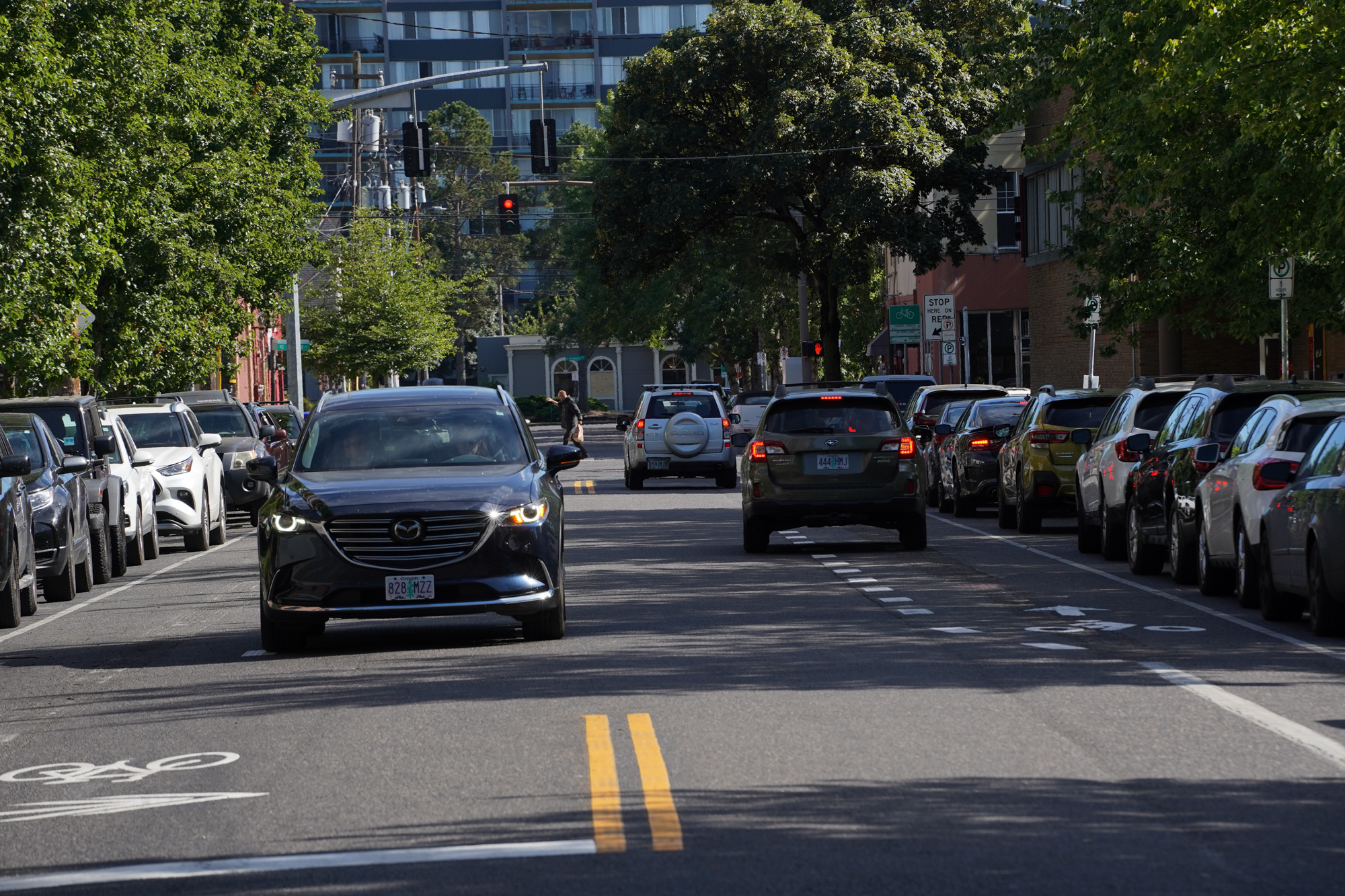
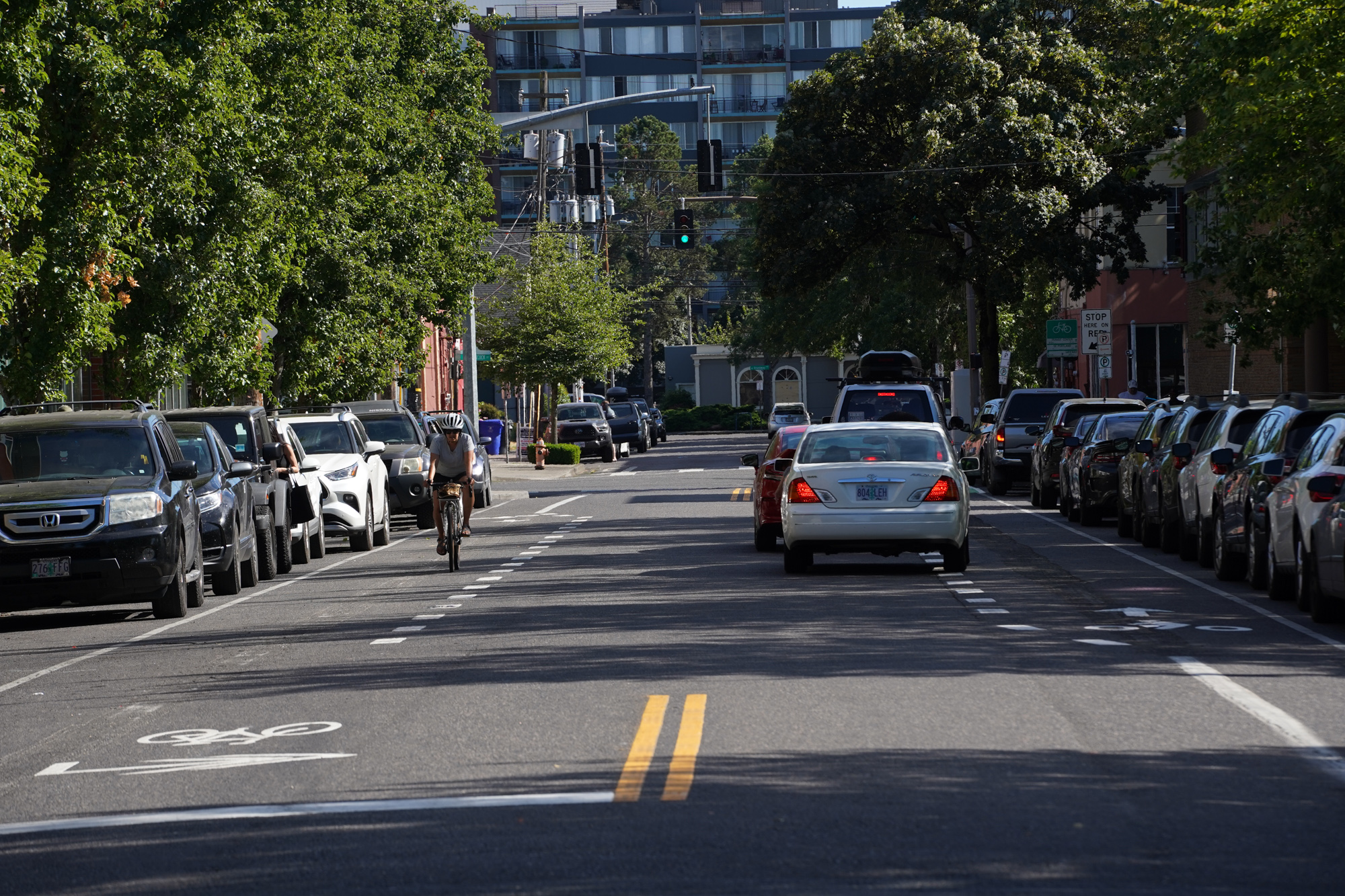

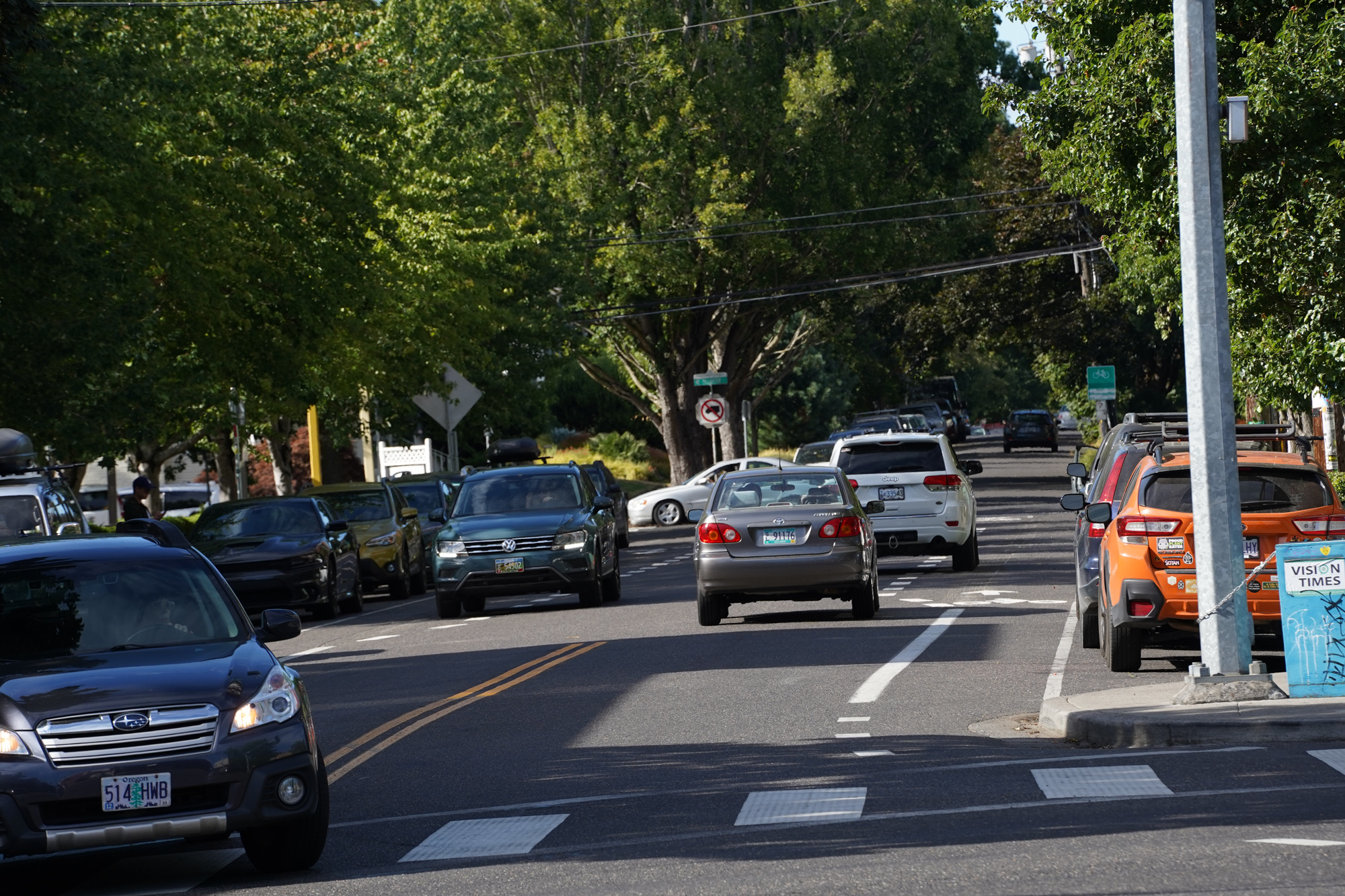
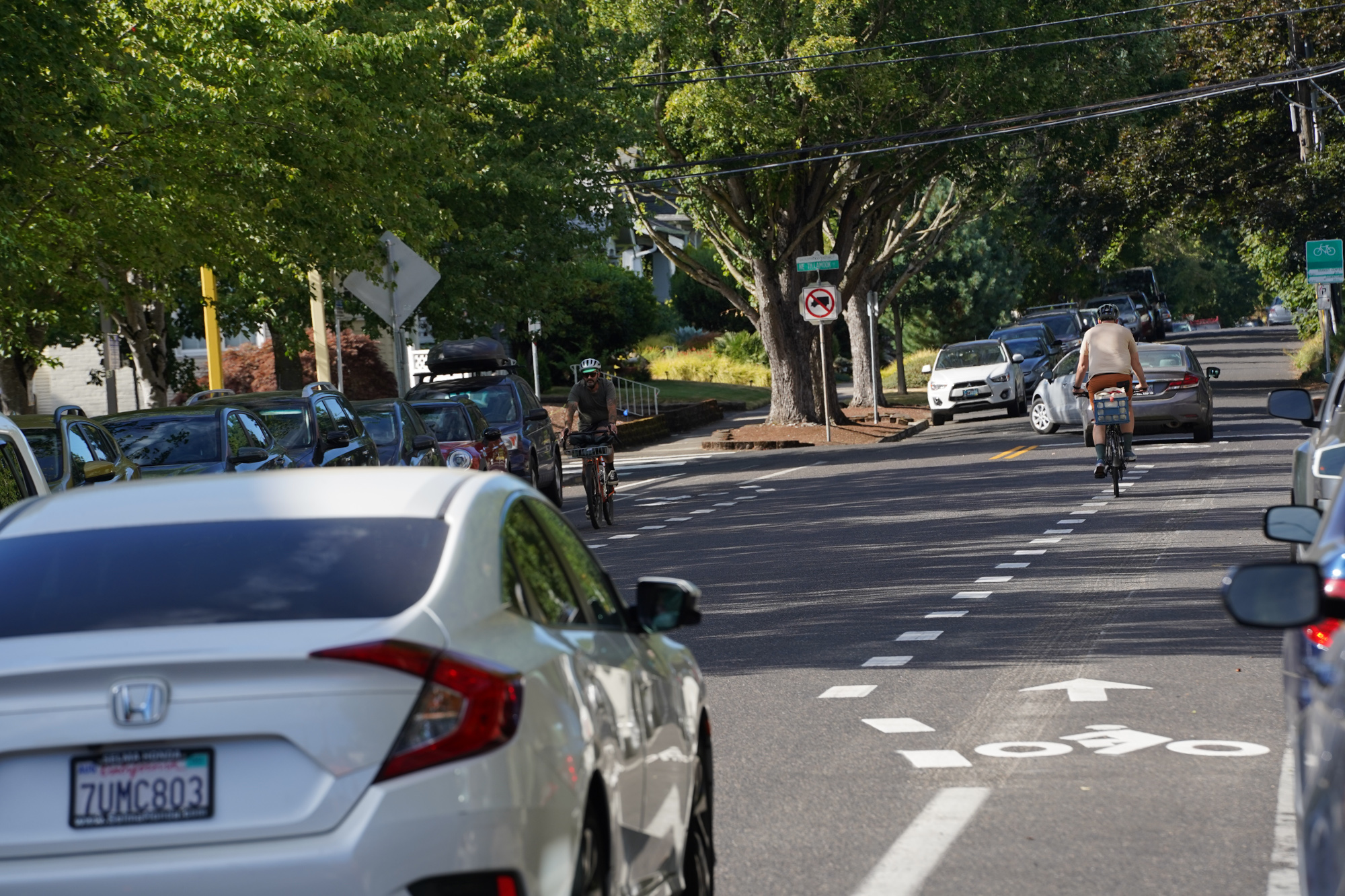
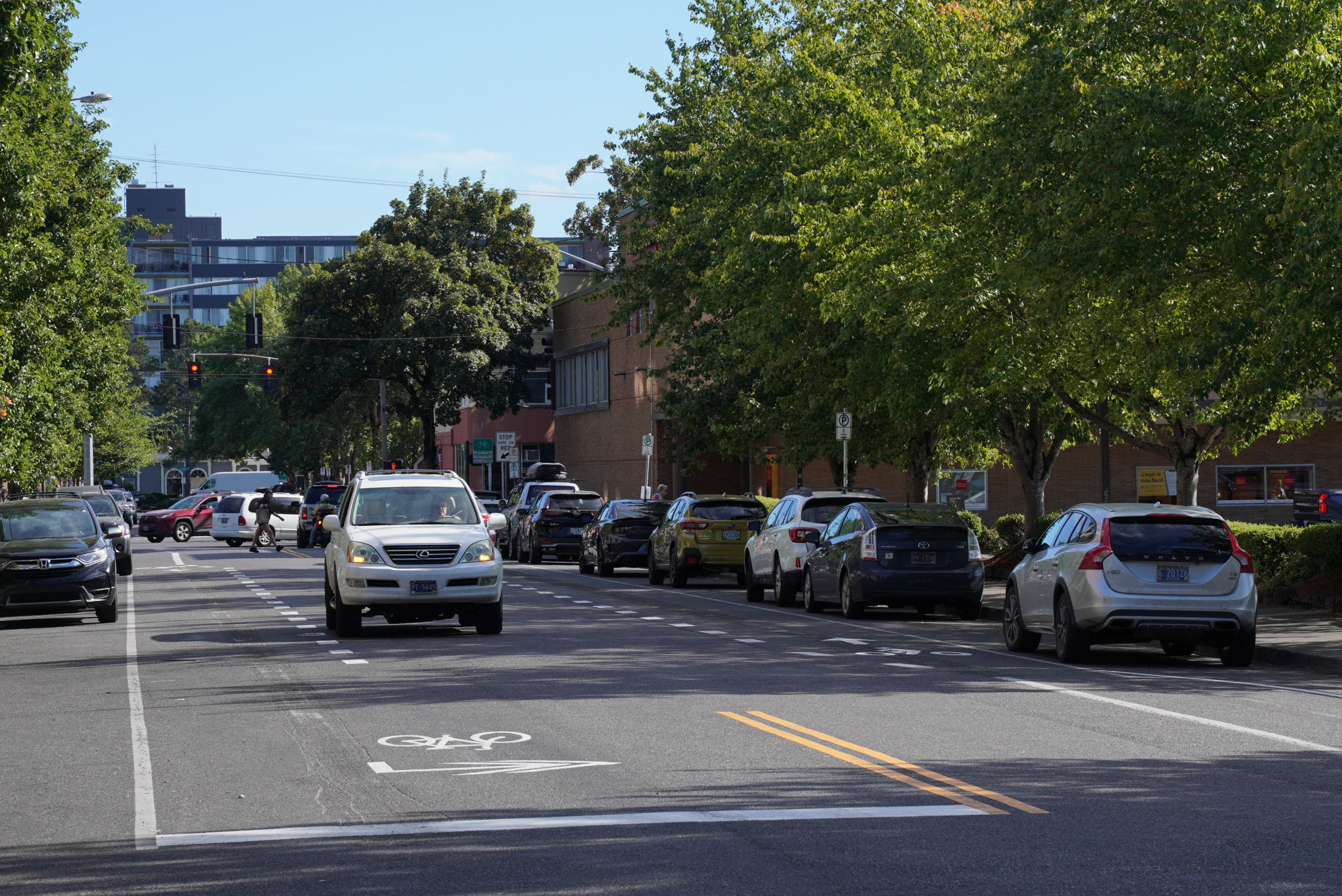
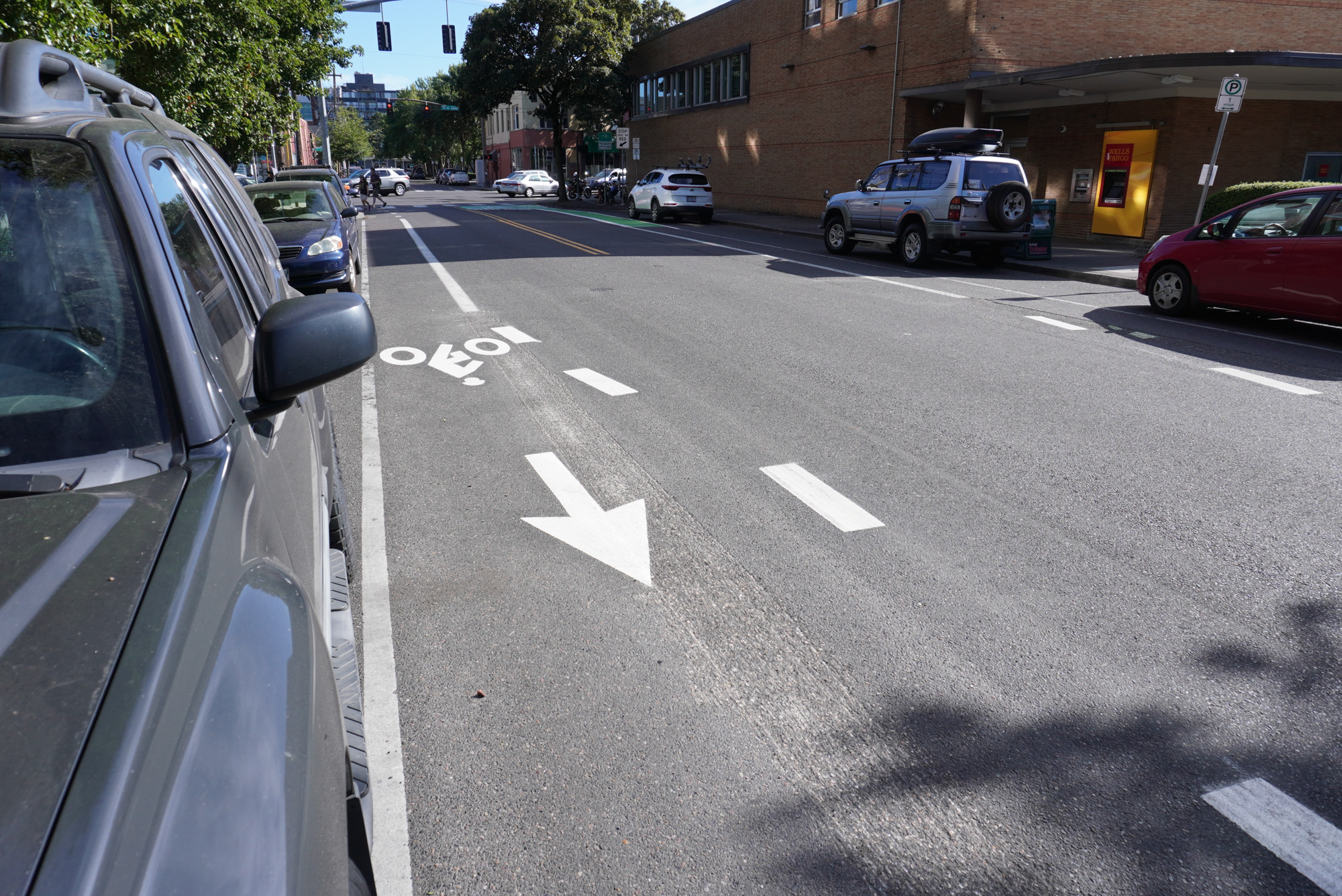
This is a very busy block, so kudos to PBOT for trying this treatment here! There’s a Whole Foods on one corner and very high parking turnover on both sides. When I observed a few days ago, everything seemed to work fine. Drivers drove in the middle when bike riders were present, and then took the full street width otherwise. Bike riders used the lanes as if they were standard lanes — and a potential added benefit of the broken paint stripe is that it encourages bikers to get further from the door zone. To further establish this block as a cycling space, PBOT has striped a traditional bike lane and added a bike symbol at the start of each block. They’ve also added intersection treatments (a sharrow/mixing zone and a bike box) to help riders transition beyond this one block.
NE 53rd between Hoyt and Irving (over I-84)
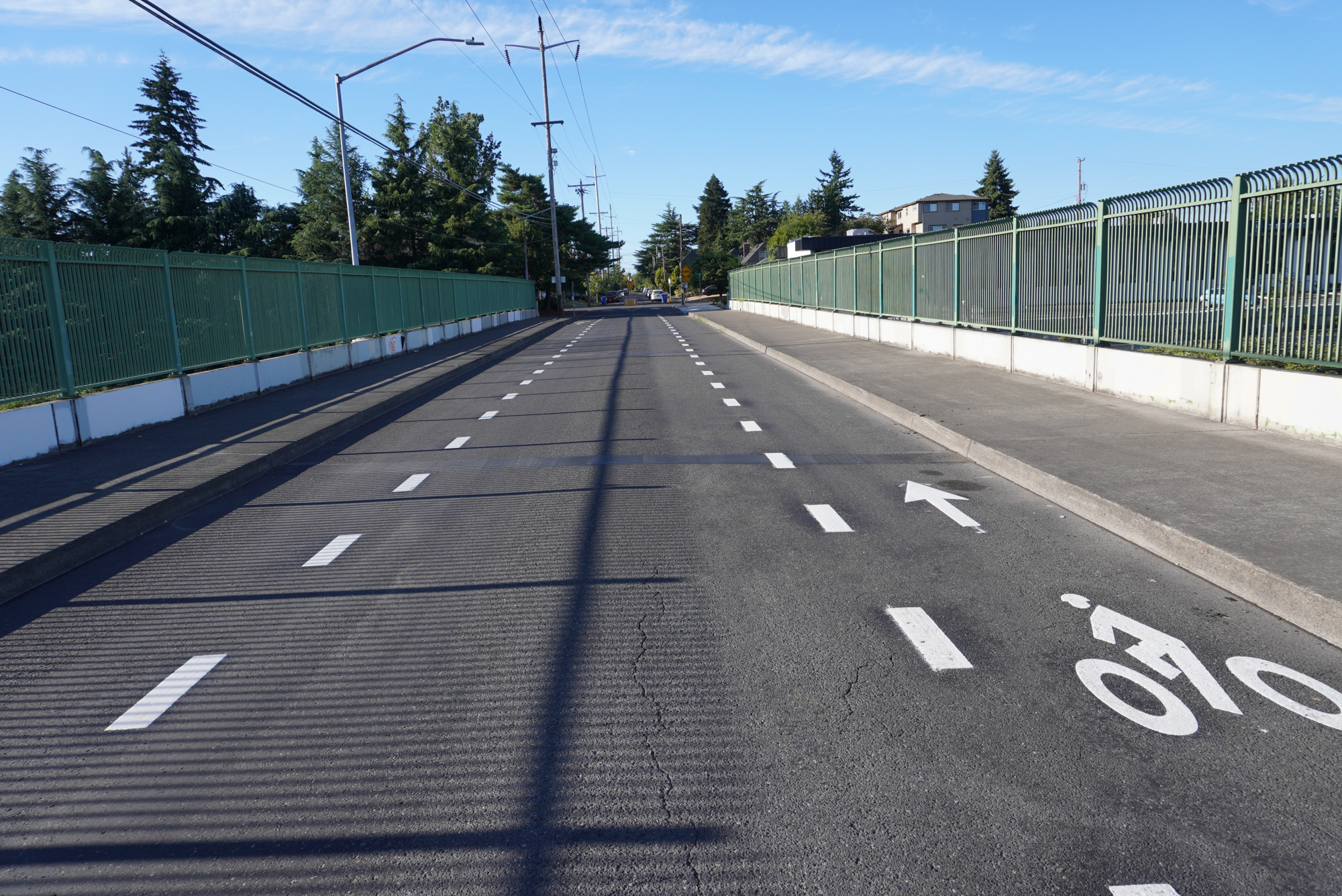


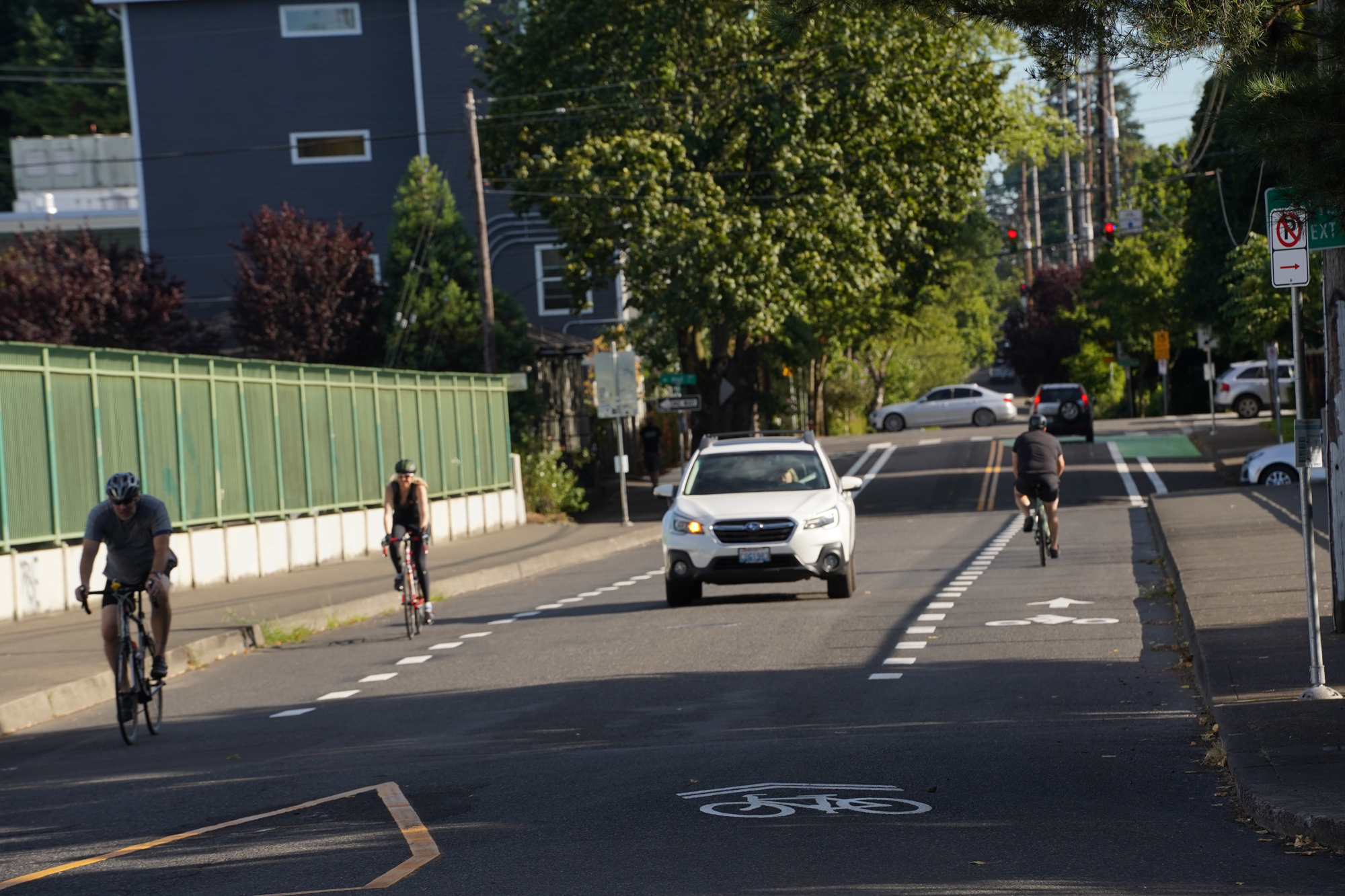
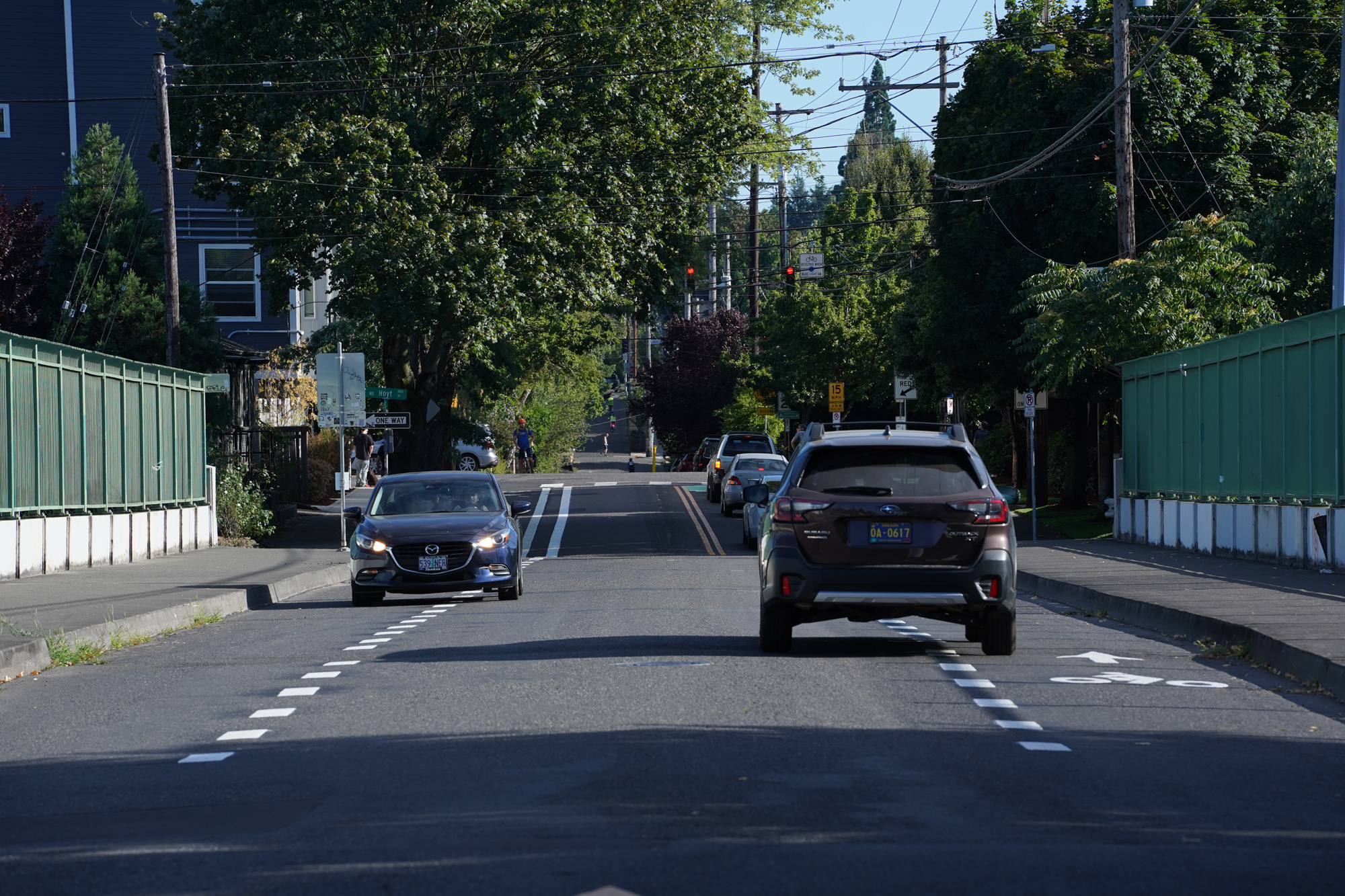

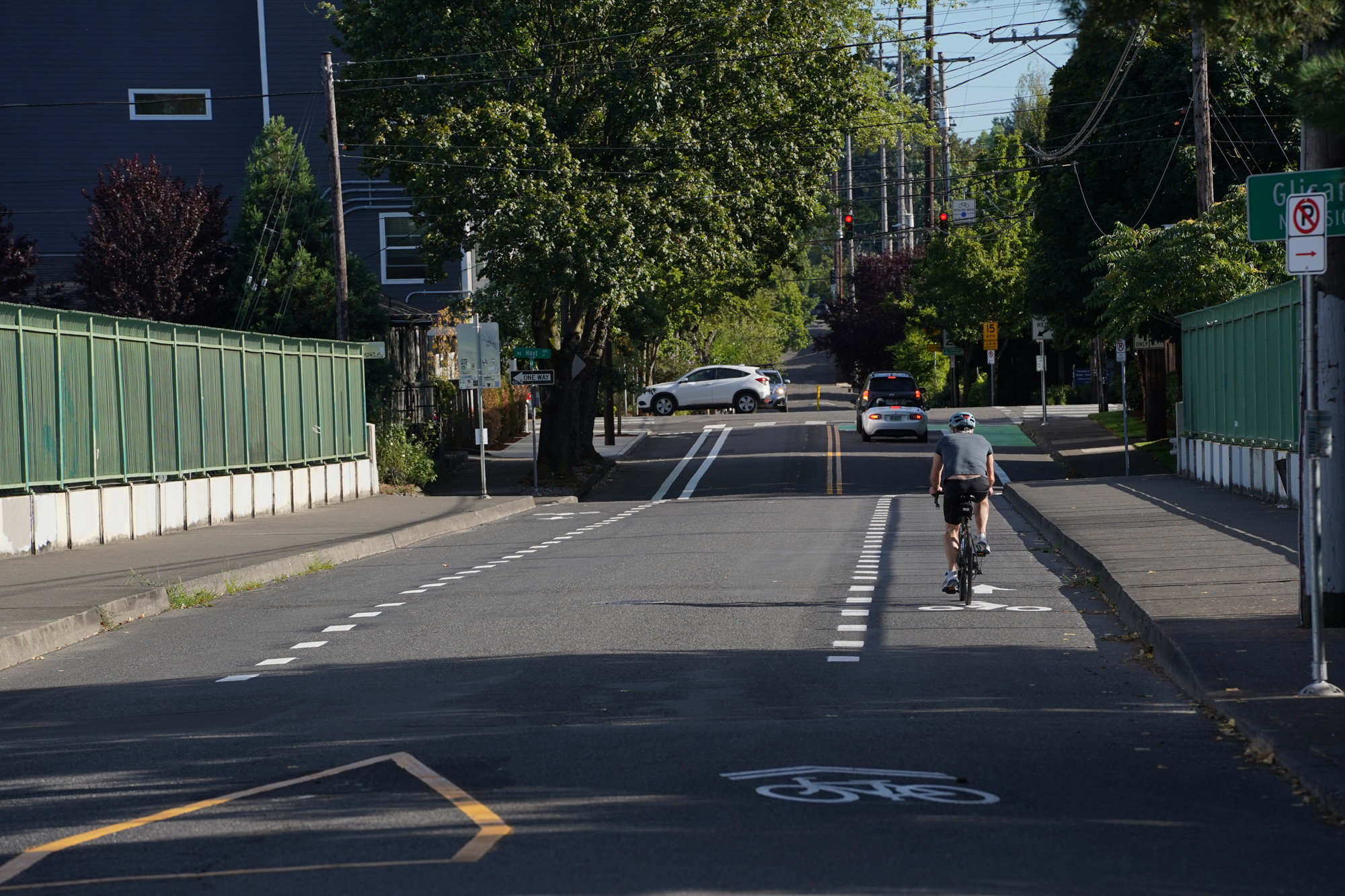
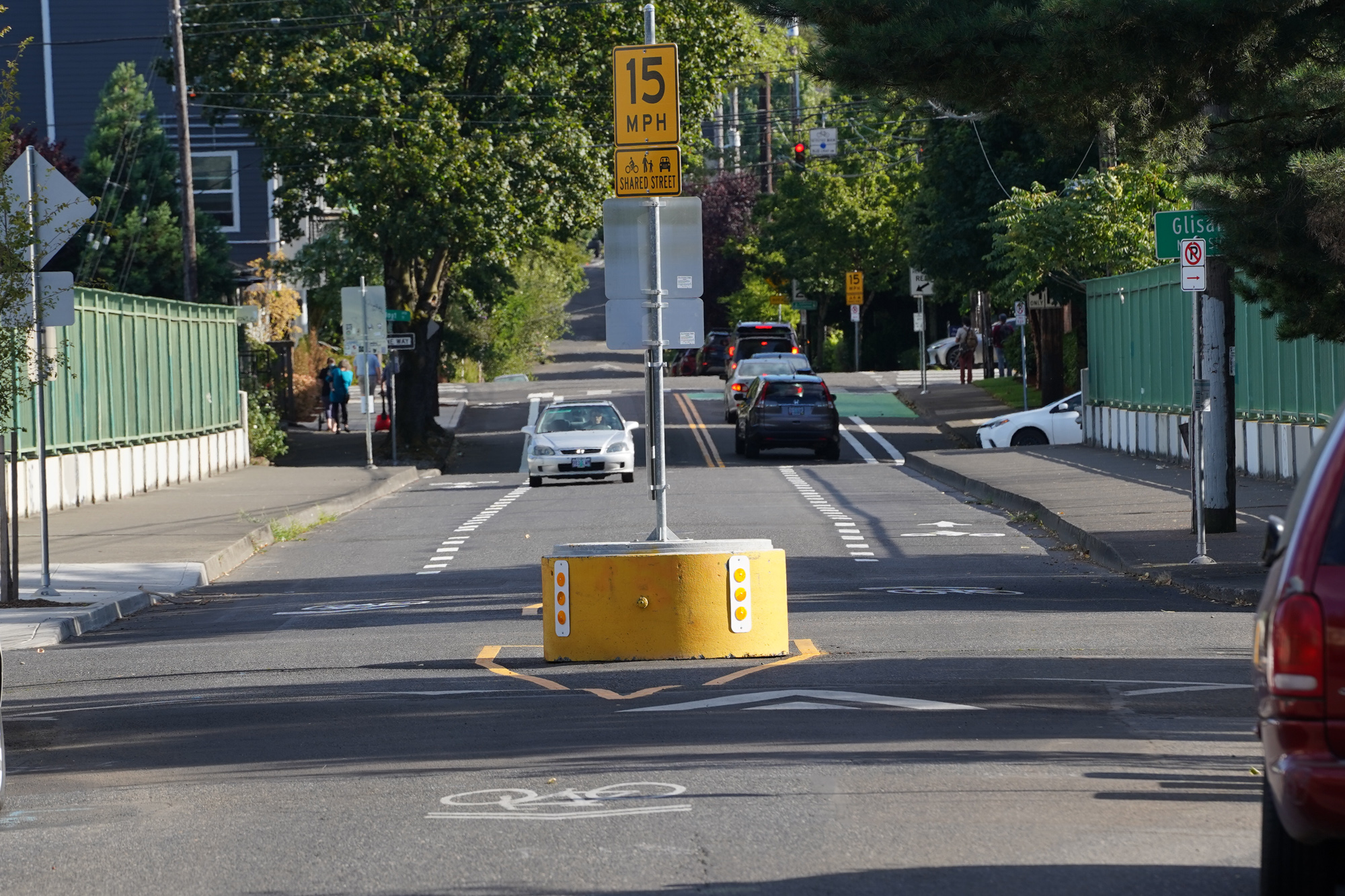
This is a key link in the bike network as a low-traffic and direct way to get across the freeway. In my observations, the advisory bike lanes worked well here too. I didn’t see any red flags in the half-hour or so that I watched. PBOT has strengthened the treatment by placing a concrete diverter and “15 MPH Shared Street” signage at the north side to further calm traffic and to make it clear this is a neighborhood greenway. The vibe on 53rd is much more relaxed and low-volume than 43rd. In some ways that creates less stress, but since the street is more wide open, drivers might behave worse more often (which is why the aforementioned diverter is so key).
Watch the video above or over on our (growing!) YouTube channel and check out the photos for a closer look. If you’ve ridden these spots, we’d love to know what you think.


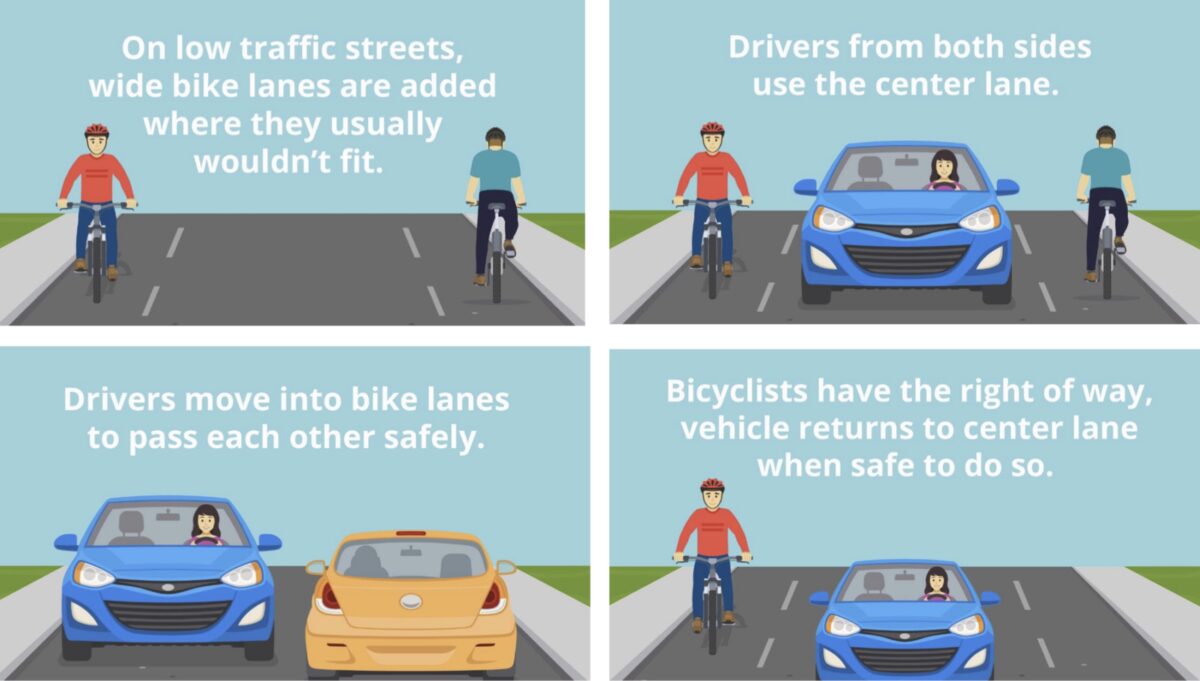
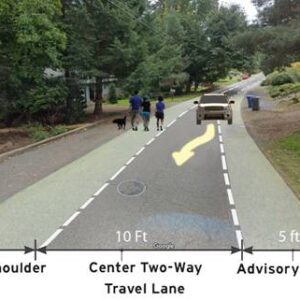
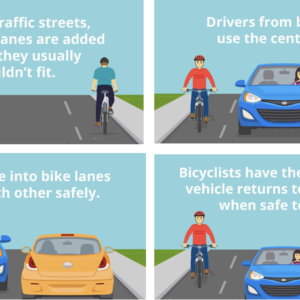
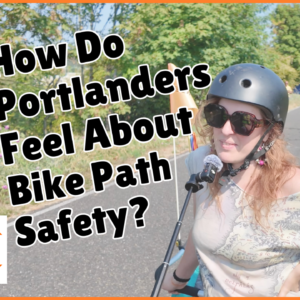

Thanks for reading.
BikePortland has served this community with independent community journalism since 2005. We rely on subscriptions from readers like you to survive. Your financial support is vital in keeping this valuable resource alive and well.
Please subscribe today to strengthen and expand our work.
They should’ve made 53rd car-free since it is a greenway, and make 43rd a one way.
Having not ridden it and only seeing it, it looks better than before but as always PBOT could’ve done more but opted to make driving just as easy.
53rd is the only signalized north-south street between 47th and 60th. It is the main access to Providence and other medical clinics for people who live in this small section of neighborhood. While Rose City Park as a whole skews affluent, this particular section is mostly working-class with a number of subsidized apartments as well. The neighborhood is also about to lose SOME of it’s signalized access to the north on 57th (long story), so 53rd is also going to be a primary N-S route for the people who live here. I’m totally fine with it being a greenway, as it has been for years, with multiple traffic circles and speed humps, and discouraging through traffic. This new treatment is fine, it just extends the greenway treatment a couple of blocks south. But to suggest cutting off local automobile access to a neighborhood that is already walled in by a freeway and a large medical complex, because driving is “just as easy” for residents as biking, strikes me as a callous disregard for the needs of area residents. On a personal note, my mom has cancer and this has been the principal route to get her to necessary treatments. We pay out-of-pocket for the ambulance service (time and mileage). Adding time and miles to this journey doesn’t strike me as good for her health or her bank account. Shorter version: YES, reduce traffic and increase greenway treatments, NO, do not cut off all vehicular access on 53rd.
Theres a bridge 4 blocks west and 5 blocks east. Wouldn’t exactly call that cutting off the neighborhood. I’m sure there would be a way to allow emergency vehicles in a car free setting.
Looking at the maps, if you are at 53rd and Halsey, it is just as fast to get to the hospital to cross at 47th and only a minute slower to cross at 60th.
I don’t see a compelling argument for letting car through traffic on a greenway.
And what in your modest proposal do you suggest for the people who live on 53rd/55th and drive to work/shopping do? Get rid of their cars altogether? Park them blocks away from home? What do you tell someone near 53rd and Irving who needs to get 4-5 blocks to physical therapy at 53rd and Glisan (and who can’t walk that far) that now it’s an ~30 block drive (looking at the same map). I’m guessing here that you are unfamiliar with the street and the neighborhood (since you say “looking at the maps” to impose a vision, Robert Moses style). 53rd is already slow speed and low-traffic. There’s no compelling argument for cutting off the residents of this neighborhood, who have already been cut off by past freeway construction, removal of sidewalks in the 60s/70s to allow truck traffic (not on 53rd but nearby), a significant portion of whom need to drive on occasion – in addition to walking/biking.
There’s an ideological argument, but, as you say, no compelling argument.
First its emergency vehicles, then its handicapped people, and then its “we can’t do that, you will inconvenience drivers”
1) allowing emergency vehicles on car-free streets is normal
2) If they can walk 4-5, they can still cross the bridge on a car free street. If they can’t walk, then mobility scooter can easily go many blocks or they are driving.
3) I do not care about inconveniencing drivers
Cars will always be the default transportation mode until we make alternatives more convenient.
I think part of the problem is that you are conflating “ambulance” with “emergency vehicle’. They are not the same. People rely on private ambulance trips all the time for regularly-scheduled treatments. And people who need physical therapy for back or leg problems aren’t going to be well-served by a mobility scooter. They may not drive themselves but they’ll take private transport. What about delivery vehicles, are those OK in your grand plan? I’ve been advocating for pedestrian and bike improvements in this neighborhood for 20 years. 53rd should be a greenway. It should not be closed to private vehicles entirely.
“I do not care about inconveniencing drivers” – OK then, that’s your opinion, doesn’t seem like anything will convince you otherwise.
No way can it be car free. All of the parking garage traffic, and patient drop off & pick up traffic from Providence feed onto 53rd.Most cars going south or turning left @ Glisan and for some access to freeway. It already gets backed up when the shifts change. Would be interested to see a video then.
I’ve used 53rd for over 40 years as both bicycle and auto crossing and it’s important for both.
I ride both of these intersections regularly, and the bike box at 43rd and Sandy is more than worth the “meh” (in my use) rest of the changes. I have never attempted turning left onto Hancock there before, instead going south to Broadway and heading east there. Now, easy-peasy, at least for me.
I’ve cycled the 53rd stretch a few times. It’s great when it works and everyone pays attention and wants to be courteous. But then there are drivers who don’t want to pay attention and/or be courteous, and this street design ends up feeling threatening and dangerous.
When cycling north, a car was driving south towards me and another car was driving north behind me. The car behind me hit the gas to pass me, the two cars passed each other just in front of me and occupied most of the width of the road, then the north bound car turned east towards the new commercial development.
This infrastructure follows the Portland pattern. A new road layout that relies on people paying attention, figuring out the intention, and choosing to drive carefully and slowly. Many drivers do this. But some don’t, and the city and the street design do nothing to stop them being dangerous. I never feel fully safe or relaxed when there are motor vehicle around, and I’ve been cycling here for decades.
Why is banning cars from certain roads out of the question? What is wrong with someone having to drive 30 blocks instead of five (as was stated in other comments)?. These are not rhetorical questions. I don’t see the problem, maybe someone can give me reasons. I am not claiming the morals grounds to ban cars. It is of course a difficult question of who to inconvenience, who to prioritize, who makes these decisions. But seriously, why do we feel entitled to such easy automobility? Our world is, and will continue to change hugely. Our current situation is unsustainable, we cannot freeze time in the moment we most prefer, and pretend we could carry on that way. We are not entitled to easy subsidized personal automobility, same way I am no longer entitled to 640 acres of farmland given to me by the government to homestead. Times change. Mistakes were made.
The new bike box on 43rd and Sandy is super helpful. The rest of 43rd is a mess and probably can’t be fixed. The advantage of these new wider bike lanes is it has everyone so confused that they are forced to slow down.
This is just, such a bad plan. Dedicated bike lanes or i generally wont ride it. Portland drivers can be and often are SUPER hostile towards bikes, and this just gives the hostile drivers an easy excuse for manslaughter.
One additional comment about the striping across the 53rd overpass (where cars now are supposed to stay toward the middle unless passing each other, and bikes to the sidwes), something that causes me concern.
I’m not sure if it will make matters better or worse, though, time will tell: There is a huge visibility problem at the south end of the overpass for vehicles coming eastbound out of Providence and expecting to turn onto or cross 53rd. The overpass railing and fence come to a hard corner, blocking visibility of 53rd, until a driver pulls way forward, almost to the point of colliding with bike or car traffic they cannot see. I know this area well, so I approach it very carefully, but Providence brings a lot of newcomers to the area.
On the one hand, moving cars on 53rd closer to the middle of the road will increase visibility for all cars, on 53rd or the side street. BUT, by designating bikes to be at the edges (when it was previously more free-form), this MAY decrease visibility between motorists and approaching cyclists. Then again, cyclists have always tended to stay toward the edges of 53rd on this overpass, so there may be no net difference in safety.
Ultimately it would be very beneficial for ODOT to angle the railing/fence at 45 degrees for the last 8 feet or so. This would dramatically increase the triangle of visibility.
Isn’t a bit of white paint wonderful?
Thanks to those white skip lines on the highway, we can count on all drivers to not suddenly change lanes and collide with other drivers, as no one is ever distracted or impaired while driving. And those 6′ gutter and door zone painted bike lanes work great, don’t they? That buffering on the faster streets are just great, isn’t it? So I’m sure we all feel reassured and totally safe knowing that car drivers would never EVER wander into an advisory bike lane when bicyclists, scooters and boarders are in the lane.
Who needs the high cost and maintenance of those niggling protected bike lanes and closed-off streets when we’ve got wonderful white paint?
You gotta love PBOT’s Vision Zero program – it assumes that since the vast majority of drivers are sober and totally focused on their driving, that statically speaking the ones who are buzzed, stoned, medicated, communicating while driving, in a damn hurry, and otherwise distracted is a negligible number and percentage, and that as long as we have 20 mph speed limit signs, traffic deaths and life-changing injuries will be zero.
Why is gas tax and vehi le fees goi g to subsidize bike lanes. Let them pay there own way.
Not all of us can or want to ride bikes to work or take mass transit with safety issues.
Our roads are ready outdated and portland keeps taking more away.
Gas taxes do not cover nearly the full costs of roads. (Look at the mess that is 82nd ave. The city is only just now in the process of taking it over from the state. That’s a perfect example of a gas-tax-funded road that the City of Portland had little say over for decades.)
And, in case you missed it, Oregon instituted a bicycle tax five years ago. Bicycle purchasers DO contribute DIRECTLY to bicycle infrastructure. https://www.oregon.gov/dor/programs/businesses/Pages/Bicycle-excise-tax.aspx
Property taxes and other local fees paid by people who do not necessarily own cars also fund streets.
Federal, State and Local general fund dollars come into road projects. Roughly a third of households have bikes. (Even parents who solely drive for transportation want safe routes for their kids to bike on.)
Lottery revenues, often paid voluntarily by people who do not own cars, also fund transportation projects.
Please take a step back (or put the car into reverse and carefully back up a few steps) and take a look at the whole funding picture.
Thank you for taking the time to write this Bob.
Do you prefer streets with no bike lanes, so that people ride bikes 10 mph in front of you in the lane? Or for that matter, do you prefer streets with no sidewalks, so the people walking walk in the street, since if bike lanes are being subsidized by gas and vehicle fees, sidewalk must be also? Or if you walk on sidewalks, do you like having people speeding past you on bikes because they don’t have bike lanes, and drivers don’t want them in the roadway? Or when you see people riding in a bike lane, do you wish they were all instead in cars ahead of you in your lane, jamming the streets?
Even if it were true that bikers don’t pay their way but drivers do, and that people biking don’t also drive and pay those taxes, there are a lot of reasons why bike lanes benefit drivers.
Fees paid by car owners (eg gas tax, license fees) are nowhere near enough to pay for our roads, let alone the other associated costs of driving. The shortfall is paid from the general tax base (eg property tax, federal funds). So, drivers are subsidized by people who do not own cars. If you take nothing else away from this discussion, please learn this and stop voicing incorrect information.
Thank you.
I think this is ridiculous we as car owners have to pay a fee to have our cars on the road to pay for road work and signals etc. and here we are having most of our dollars go to altering our drivable roads to bike roads and they pay none of it bikes aren’t registered they pay nothing towards any of the road changes being done in there favor Taking away from the car owners who are the ones paying for it not fair I don’t want to share my road until they start paying there share of the work being done
Not ok to take away from people who put money into the roads and give to bikers who pay nothing
Can we just abolish the bicycle sales tax now? It was supposed to silence the haters who grouse about all the money being spent on bike infrastructure, and it clearly hasn’t accomplished that. Let’s just raise the gas tax by at least a dollar a gallon if entitled drivers are going to complain anyway.
I just saw a video that shows something you might like. The street originally had one narrow lane each way. That configuration forced bikers to ride in the traffic lanes, meaning cars would get stuck behind slow-moving bikes. The project did new striping that directed bikes to the edges of the street, reserving the center for cars, so they didn’t get stuck behind slow bikes. Not only did it benefit drivers, it was cheap–just some restriping and signs. Here’s a link: https://youtu.be/51o7hCKJZLg?t=10
Fees paid by car owners (eg gas tax, license fees) are nowhere near enough to pay for our roads, let alone the other associated costs of driving. The shortfall is paid from the general tax base (eg property tax, federal funds). So, drivers are subsidized by people who do not own cars. If you take nothing else away from this discussion, please learn this and stop voicing incorrect information.
Thank you.
Actually, the shortfall isn’t being adequately funded either. PBOT has over $1 Billion in maintenance backlog, something they have in common with most other cities, counties, and states throughout the USA.
Since Oregonians (in common with most Americans) aren’t willing to increase taxes, wouldn’t a for more pragmatic solution be to entirely abandon any pretense at local street maintenance and focus our limited transportation dollars towards freeways, bridges, mass transit, and pathways? Basically let all city streets, arterial roadways included, simply go to pot?
You’re right, of course. I don’t think we should be paying all this money in a failed attempt to maintain current infrastructure. I was just trying to keep the message simple.
The only sane course ahead is to identify key transportation infrastructure, maintain that, and accept that the rest will atrophy.
The last I heard from PBOT, it would take ten years at current work rates to catch up with the maintenance backlog, and this doesn’t account for the deterioration that would occur during those ten years. I.e. we would need 10x the funding to just catch up with delayed maintenance. This is just not going to happen.
We have far too much deeply-subsidized infrastructure for SUVs/personal trucks and, ultimately, we will need to decommission a lot of it to be able to maintain a functional transportation system. Then again USAnians only do the decent and rational thing after exhausting all alternatives.
Really? How are these any different from sharrows? Sure, let’s just keep making it more confusing. PBOT should finally settle on some useful designs and some reasonable descriptions of them and call it good. They blew the original rollout of sharrows over a decade ago, and now we’ve got to deal with this? Where is the motorist education campaign? Or as usual is it supposed to be by osmosis between PBOT’s squirrelly design and each individual motorist???
I’m surprised there aren’t more comments like this about the striping, instantly looks like a disaster to me.
Useful you say? How would you propose they arrive at those useful designs if they don’t experiment a bit in an effort to find one (or two) that work well for keeping cyclists cycling & motorist from running them over? And such experiments take a bit of time to determine which do or do not work as well as one would hope…
I mean, I agree to some degree; they have & do continue to do some rather silly (if not outright stupid) things & I’m not entirely convinced how this example will really be “better”.
There are significant differences between edge lane roads (ELRs) and sharrows. Sharrows always put bicyclists in the traffic flow with cars. ELRs always give motorists and bicyclists their own lanes, except when cars must pass one another. On a low volume street, cars needing to pass one another while near a vulnerable road user, occurs very infrequently.
The Dutch use this treatment a lot on appropriate roads. For more than 50 years. As do other countries. It works.
I understand the desire to have protected bike lanes everywhere, especially in a large city. But the fact is, even the Dutch don’t feel the need to put protected infrastructure everywhere and they’ve created bike heaven on earth, right?
The real question is when does one transition to a physically protected facility.
If anybody wants to educate themselves in more detail on this treatment, I recommend advisorybikelanes.com.